What is
@AaveAave? 🔍
Aave is a decentralized lending protocol that lets people lend, borrow and earn interest on crypto assets, without any middlemen.
So instead of relying on banks for these services, you rely on transparent, smart contracts that run on the blockchain.
Founded in 2017 by
@StaniKulechov, Aave was originally called ETHLend.
They started as a peer-to-peer protocol that matched lenders to borrowers but later pivoted to a system where people borrow from liquidity pools and rebranded to Aave which is Finnish for ghost 👻
How does it work? 💡
For lenders:
Anyone can deposit their crypto assets into a liquidity pool and earn interest on it
For borrowers:
Anyone can borrow crypto assets from a liquidity pool and pay interest on it
The rates are calculated algorithmically based on liquidity.
To facilitate lending & borrowing, Aave issues two types of tokens:
1. aTokens - issued against deposited assets to lenders, they increase proportionally with interest generated by the AAVE pool
2. $AAVE tokens - this is Aave's DAO token that also incentivizes borrowers
There are two types of loans one can get from AAVE:
1. Regular loan - deposit collateral and borrow from the liquidity pool
2. Flash loan - borrow without any collateral (we'll explain)
The latter is
@AaveAave's key feature ✨
What's a regular loan in
@AaveAave? 💰
Borrowers need to deposit collateral in the form of any accepted asset in the liquidity pool before they can borrow.
For example, you can put in $DAI as collateral and borrow $ETH from Aave.
What are Flash loans? ⚡
Flash loans allow anyone to borrow assets instantly without having to put up any collateral. But there is a catch 😅
The flash loan must be issued and paid back with any interest and fees within a single block on the blockchain.
So what's the point of a flash loan? 🤔
Flash loans are mostly used by traders who practice 'arbitrage' – an investment strategy in which an investor simultaneously buys and sells an asset in different markets to take advantage of a price difference to generate a profit.
Why is
@AaveAave important in DeFi? 💫
We can categorize this into three main components:
1. Liquidity pools
2. Permissionless
3. Non-custodial
Let's break it down 👇
1. Liquidity pools 🏊♂️
This removes the need to wait for a bank to match a borrower to a lender who's willing to lend at a fixed price and then pay the bank fees for that service.
Instead of trusting a centralized entity with your funds, it's in a secure liquidity pool 🤝
2. Permissionless 🙅
There are no gatekeepers or borders to entry. Anybody anywhere in the world now has access to acquiring low-interest loans without any barriers like credit scores, KYCs, employment status, etc.
No more barriers set by banks and high-interest rates ⚖️
3. Non-custodial 📝
For the first time, a non-person entity, like
@AaveAave's lending smart contracts, is able to hold and manage real money.
When you deposit assets on Aave, nobody has control over your assets but you. This is not the case in traditional finance 🥲
If you want to learn more about
@AaveAave in-depth, check out their FAQs doc:
https://t.co/vRTXUnwuMp @WhiteboardCryp1 also has a great explainer video if you want more specifics:
https://t.co/Rzwh5wVb2Q
We're on a mission to lower barriers to the space & make it simple for anyone to invest in crypto through indexes 📈
Our first index tracks the performance of 10 DeFi assets including $AAVE, with just a few taps on your phone 📲
Join the waitlist:
https://t.co/xGHVV2k5Ue
If you found this thread to be valuable, we'd highly appreciate a RT as it helps us reach out to more people wanting to learn about web3/crypto 🙌
Do follow us at
@alongsidefi for more such threads as we're investing heavily in education ✨
Have a great day! ☀️





